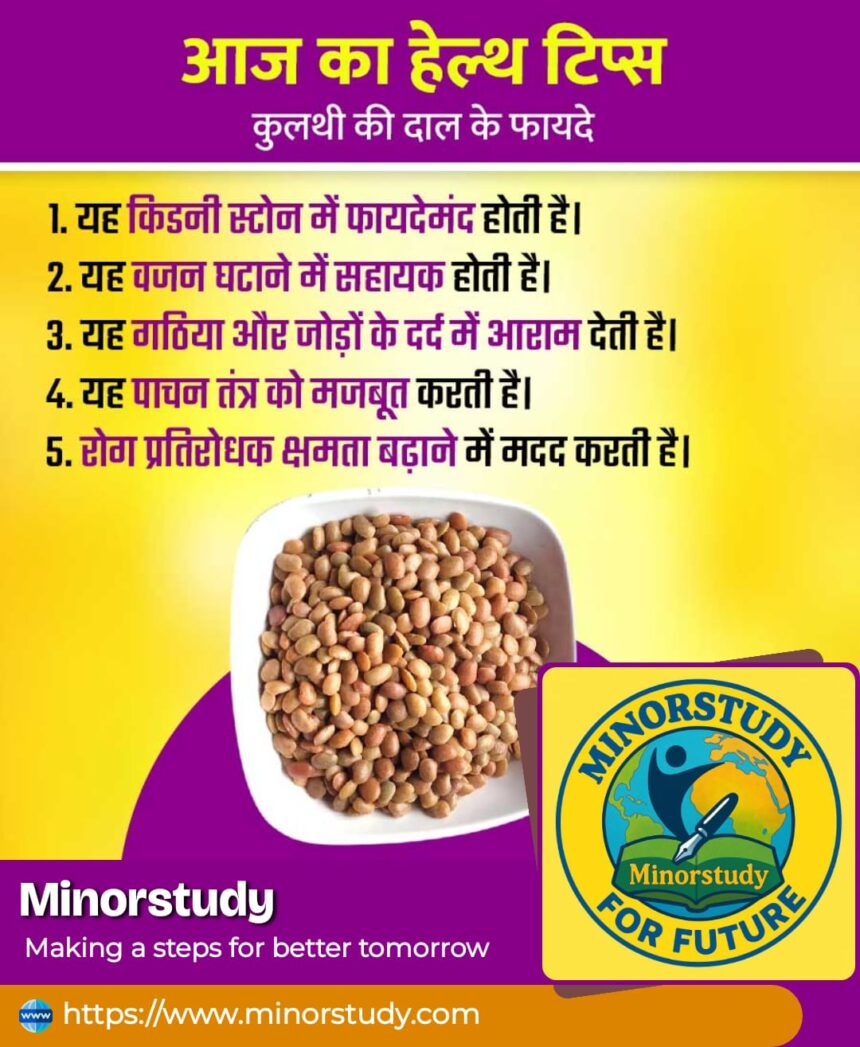🌱 Introduction: Rediscovering Nature’s Forgotten Pulse
In a world full of fancy supplements and imported superfoods, there exists a humble Indian legume that has silently served generations — Horse Gram Dal (Kulthi Dal). Long celebrated in Ayurveda and folk medicine, this underrated grain is now making a comeback in modern nutrition for its incredible health benefits.
- 🌱 Introduction: Rediscovering Nature’s Forgotten Pulse
- 🧬 What is Horse Gram Dal?
- 📜 History and Traditional Significance
- 🕰️ Timeline of Horse Gram’s Relevance
- 🌟 5 Powerful Health Benefits of Horse Gram Dal
- 1. 💧 Helps Dissolve Kidney Stones
- 2. ⚖️ Aids in Weight Loss
- 3. 🦴 Eases Joint Pain & Arthritis
- 4. 🧠 Boosts Digestive Health
- 5. 🛡️ Enhances Immunity
- 📋 Additional Nutritional Facts (Per 100g Raw Horse Gram)
- 🌍 Social & Cultural Importance
- 🎉 Observance: How It’s Honored in Indian Culture
- 💬 FAQs – Frequently Asked Questions
- Q1. Can Horse Gram be eaten daily?
- Q2. Is Horse Gram good for diabetes?
- Q3. Is Horse Gram safe during pregnancy?
- Q4. How to eat Horse Gram for kidney stones?
- Q5. Does Horse Gram increase body heat?
- 💖 Wishing & Healthful Blessings
- 🧠 Importance in Our Daily Lives
- 🧾 Key Takeaways: Why You Should Eat Horse Gram Dal
- ✍️ Conclusion: The Comeback of a Super Pulse
Whether you’re trying to manage weight, improve kidney health, or boost immunity, Horse Gram Dal is a hidden gem in your kitchen that deserves the spotlight.
🧬 What is Horse Gram Dal?
Botanical Name: Macrotyloma uniflorum
Common Names: Kulthi (Hindi), Kollu (Tamil), Ulavalu (Telugu), Hurule (Kannada)
Category: Legume/pulse
Taste Profile: Earthy, nutty, slightly bitter
Color: Brownish-red with a hard shell
Horse Gram Dal was traditionally fed to horses and cattle due to its high protein content and stamina-boosting qualities — hence the name. But over centuries, it has been embraced in human diets across India for its therapeutic effects.
📜 History and Traditional Significance
Horse Gram finds its origin in Indian and African agriculture and has been cultivated for over 3000 years. In Siddha and Ayurvedic medicine, it was prescribed for urinary stones, rheumatism, and bile disorders.
Key historical uses:
Ayurveda: For detoxification, bile balance, and urinary issues.
Siddha Medicine: Used for treating fevers, bronchial problems, and obesity.
Tribal diets: In drought-prone regions, it served as a resilient food source due to its drought tolerance and nutritional density.
🕰️ Timeline of Horse Gram’s Relevance
| Period | Event |
|---|---|
| ~1000 BCE | Used in Siddha texts as medicinal food |
| 500 BCE | Ayurveda documents its detox benefits |
| Medieval India | Staple food in South Indian rural households |
| 20th Century | Begins to decline in urban diets |
| 21st Century | Regains interest as a superfood in modern nutrition |
🌟 5 Powerful Health Benefits of Horse Gram Dal
1. 💧 Helps Dissolve Kidney Stones
Contains diuretic compounds that flush toxins and excess calcium from kidneys.
Boiled Horse Gram water is a natural remedy recommended by Ayurvedic doctors to dissolve and prevent renal calculi.
2. ⚖️ Aids in Weight Loss
High in dietary fiber and protein that keeps you full longer.
Low in calories, yet nutritionally dense.
Promotes fat metabolism and detoxification of fatty acids.
Tip: Add sprouted horse gram to your morning smoothie or salad for a metabolism kick!
3. 🦴 Eases Joint Pain & Arthritis
Rich in calcium, iron, and polyphenols, it reduces inflammation in joints.
Traditional home remedies use Kollu Rasam (spicy soup) to relieve rheumatism.
4. 🧠 Boosts Digestive Health
Its insoluble fiber enhances bowel movements, reducing constipation and acidity.
Acts as a natural detoxifier for the digestive tract.
Good for gastric ulcers when taken with warm water.
5. 🛡️ Enhances Immunity
Rich in iron, molybdenum, and antioxidants.
Boosts red blood cell production, oxygen circulation, and general stamina.
Strengthens immune responses especially during changing seasons.
📋 Additional Nutritional Facts (Per 100g Raw Horse Gram)
| Nutrient | Amount |
|---|---|
| Protein | 22g |
| Fiber | 5g |
| Iron | 6.7mg |
| Calcium | 287mg |
| Carbohydrates | 57g |
| Fat | 0.5g |
| Calories | ~320 kcal |
🌍 Social & Cultural Importance
In South India, Horse Gram is an important part of folk cuisine.
Celebrated in tribal festivals and harvests as a pulse of strength.
Used in local immunity tonics for children and elderly during monsoon.
Seen as “food of the poor”, it ironically offers premium nutrition that even expensive health supplements can’t match.
“In rural kitchens, Horse Gram was not poor man’s food—it was wise man’s food.”
🎉 Observance: How It’s Honored in Indian Culture
In Tamil Nadu and Andhra Pradesh, recipes like Kollu Rasam or Ulavacharu are served during winter.
Ayurveda Panchakarma clinics include Horse Gram soups in post-detox meals.
In folk medicine traditions, Horse Gram is soaked overnight and consumed raw with jaggery for treating anemia and weakness.
💬 FAQs – Frequently Asked Questions
Q1. Can Horse Gram be eaten daily?
Yes, but it should be soaked or cooked. Raw consumption in excess can be hard on digestion.
Q2. Is Horse Gram good for diabetes?
Absolutely. It has a low glycemic index and helps in blood sugar regulation.
Q3. Is Horse Gram safe during pregnancy?
In moderation, yes. However, consult a doctor before adding any high-fiber food during pregnancy.
Q4. How to eat Horse Gram for kidney stones?
Boil 25g of Horse Gram in 1 liter of water. Reduce to half, strain, and drink on an empty stomach daily.
Q5. Does Horse Gram increase body heat?
Yes. It has “ushna” (heat-inducing) properties. Ideal in winter, should be moderated during summer.
💖 Wishing & Healthful Blessings
“May your health be as strong as a horse — with the grace of Horse Gram Dal!”
“Wishing you energy, balance, and daily strength with every bite of this ancient pulse.”
🧠 Importance in Our Daily Lives
In today’s fast-paced, processed-food-dominated life, we often ignore ancestral wisdom. Horse Gram brings us back to:
Clean eating
Sustainable health
Affordable nutrition
Prevention over cure
It teaches us that true wellness lies in simplicity, not expensive branding.
🧾 Key Takeaways: Why You Should Eat Horse Gram Dal
✅ Natural medicine for kidney stones and detox
✅ Boosts digestive and metabolic health
✅ Helps in sustainable weight loss
✅ Powerful anti-inflammatory agent for joints
✅ Packed with protein, iron, calcium — especially for vegetarians
✍️ Conclusion: The Comeback of a Super Pulse
Horse Gram Dal is no longer just a forgotten grain of the past. It’s a nutritional powerhouse, a natural healer, and a gift from ancient Indian wisdom.
Whether you want to lose weight, heal your body, or just add more whole foods to your diet, Horse Gram Dal deserves a space in your kitchen and in your heart.
So the next time you’re looking for something wholesome, healing, and hearty, don’t scroll through expensive diet charts—simply go back to this mighty little lentil.








